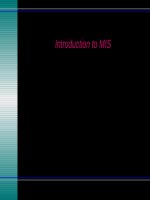Lecture Management information systems - Chater 4: Computer software
Bạn đang xem bản rút gọn của tài liệu. Xem và tải ngay bản đầy đủ của tài liệu tại đây (1.79 MB, 74 trang )
Copyright © 2006, The McGrawHill Companies, Inc. All rights reserved.
4-1
Chapter
4
Computer Software
Copyright © 2006, The McGrawHill Companies, Inc. All rights reserved.
4-2
Learning Objectives
1. Describe several important trends
occurring in computer software.
2. Give examples of several major types of
application and system software.
3. Explain the purpose of several popular
software packages for end user
productivity and collaborative computing.
Copyright © 2006, The McGrawHill Companies, Inc. All rights reserved.
4-3
Learning Objectives
4. Outline the functions of an operating
system.
5. Describe the main uses of computer
programming software, tools, and
languages.
Copyright © 2006, The McGrawHill Companies, Inc. All rights reserved.
4-4
What is Software?
Definition:
• Various kinds of programs used to
operate computers and related devices
Copyright © 2006, The McGrawHill Companies, Inc. All rights reserved.
4-5
Case #1: Writing Software for Processes
Microsoft’s Business Solutions Division:
• Teams formed for different industries
• Injected industry-specific codes directly
into its core software platforms
• Hired business technology professionals
steeped in sector-specific knowledge
Copyright © 2006, The McGrawHill Companies, Inc. All rights reserved.
4-6
Case #1: Writing Software for Processes
Microsoft’s New Strategy:
• Creating accelerators aimed at business
processes common to companies in a given
industry
• Inserting industry-enabling layers to serve the
needs of a broad base of companies in a
particular sector
• Seeking partnerships with vendors that have
deep industry roots
Copyright © 2006, The McGrawHill Companies, Inc. All rights reserved.
4-7
Case #1: Writing Software for Processes
1. A common phrase among IT
professionals is “The world views its
data through Windows”. Why does
Microsoft dominate the desktop and
networked software market? Visit its
website at www.microsoft.com and
review its broad range of software
products and services to help with your
answer.
Copyright © 2006, The McGrawHill Companies, Inc. All rights reserved.
4-8
Case #1: Writing Software for Processes
2. How successful will Microsoft be in competing
with software vendors who specialize in
vertical market applications like health care,
retail, and specialty services? Why?
3. Do you agree with Microsoft’s strategy to
develop industry-specific partners to capitalize
on opportunities in both large and small
business sectors? Is there an advantage or a
disadvantage to being one of Microsoft’s
partners in this type of relationship? Explain.
Copyright © 2006, The McGrawHill Companies, Inc. All rights reserved.
4-9
Case #1: Writing Software for Processes
4. Does Microsoft’s entry into industryspecific applications signal the end for
smaller industry-specific software
developers? What changes in strategy
by such developers are necessary to
compete with Microsoft?
Copyright © 2006, The McGrawHill Companies, Inc. All rights reserved.
4 - 10
Types of Software
Copyright © 2006, The McGrawHill Companies, Inc. All rights reserved.
4 - 11
Types of Software
• Application Software - performs
information processing tasks for end
users
• System Software – manages and
supports operations of computer systems
and networks
Copyright © 2006, The McGrawHill Companies, Inc. All rights reserved.
4 - 12
Application Software
• General-Purpose – programs that perform
common information processing jobs for
end users
• Application-Specific – support specific
applications of end users in business and
other fields
Copyright © 2006, The McGrawHill Companies, Inc. All rights reserved.
4 - 13
How is Software Developed?
• Custom Software – software applications
that are developed within an organization
for use by that organization
• Commercial Off-the-shelf (COTS)
Software – software that is developed by
a software developer with the intention of
selling the software in multiple copies
Copyright © 2006, The McGrawHill Companies, Inc. All rights reserved.
4 - 14
General-Purpose Application Software
•
•
•
•
•
•
•
•
•
Software Suites
Web Browsers
Electronic Mail
Word Processing
Spreadsheets
Database Managers
Presentation Graphics
Personal Information Managers
Groupware
Copyright © 2006, The McGrawHill Companies, Inc. All rights reserved.
4 - 15
Software Suites
Copyright © 2006, The McGrawHill Companies, Inc. All rights reserved.
4 - 16
Integrated Packages
Definition:
• Combine some of the functions of several
programs into one software package
Copyright © 2006, The McGrawHill Companies, Inc. All rights reserved.
4 - 17
Graphical User Interface (GUI)
Definition:
• Icons, tool and status bars, menus, and
so on, which gives an application its look
and feel
Copyright © 2006, The McGrawHill Companies, Inc. All rights reserved.
4 - 18
Web Browser
Definition:
• Software interface used to point and click
through the hyperlinked resources of the
Internet
Copyright © 2006, The McGrawHill Companies, Inc. All rights reserved.
4 - 19
Web Browser
Copyright © 2006, The McGrawHill Companies, Inc. All rights reserved.
4 - 20
Electronic Mail & Instant Messaging
• Electronic Mail – software used to send
and receive electronic messages and file
attachments via the Internet, intranets or
extranets
• Instant Messaging (IM) – software used to
send and receive electronic messages
instantly to facilitate real time
communication and collaboration
Copyright © 2006, The McGrawHill Companies, Inc. All rights reserved.
4 - 21
Copyright © 2006, The McGrawHill Companies, Inc. All rights reserved.
4 - 22
Word Processing & Desktop Publishing
• Word Processing – software that supports
the creation, editing, revision and printing
of documents
• Desktop Publishing (DTP) – software that
supports the production of materials that
look professionally published
Copyright © 2006, The McGrawHill Companies, Inc. All rights reserved.
4 - 23
Word Processing
Copyright © 2006, The McGrawHill Companies, Inc. All rights reserved.
4 - 24
Electronic Spreadsheets
Definition:
• Software that supports the development
of electronic worksheets consisting of
rows and columns used for business
analysis, planning and modeling
Copyright © 2006, The McGrawHill Companies, Inc. All rights reserved.
4 - 25









